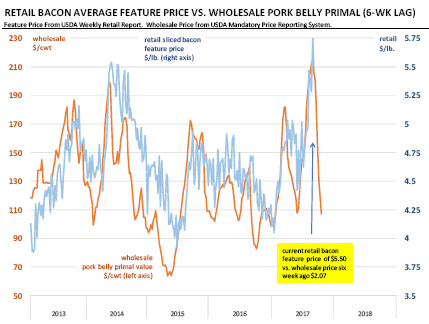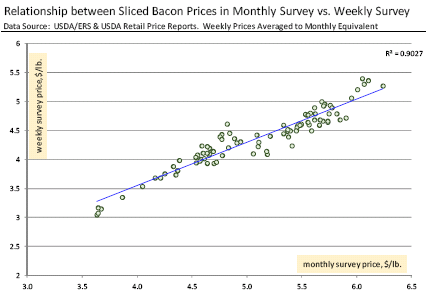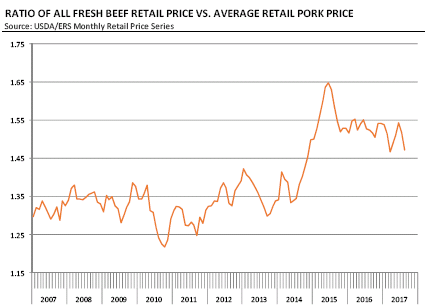



CME: Sharp Decline in Pork Belly Prices
US - The sharp decline in belly prices has been astounding (down 50 per cent in the last few weeks). But it also makes a bit more sense once you take a step back and look at the extreme volatility in this product during the last few years, writes Steiner Consulting Group, DLR Division, Inc.The following chart is one we have shown several times in the last few months to illustrate the interplay between wholesale and retail prices in the belly/sliced bacon market. It was not long ago when market participants were looking at pork belly prices over $200/cwt and marveling at the level of consumer demand supporting such prices.

But often demand discussions that center over wholesale prices fail to recognize that one needs to wait until the consumer is faced with the shift in price before coming to any meaningful conclusions. Demand indexes use retail prices for precisely that reason. Often it takes time for market participants to adjust to shifts in supply availability.
They also may employ risk management tools that delay the effect of higher prices. And finally, some end users may simply have commitments that they need to fulfill and therefore have little choice but to pay up, not because their demand curve has changed but because, in the short term, they simply have no choice.
Yes, pork belly prices in July jumped over $200/cwt but that was not the price the consumer was paying in the meat case. Retail bacon prices have now adjusted to reflect wholesale prices earlier in the summer. According to the monthly USDA/ERS retail price data released Thursday, the average August retail bacon price reached an all-time record high of $6.24/lb., 7.3 per cent higher than the previous month and 14.5 per cent higher than the previous year.
The previous record retail price for bacon was set in the summer of 2014, when it surpassed $6 per pound. Back then, retail bacon prices remained at elevated levels between May and October as the spread of PEDv caused a significant shortfall in pork supplies. That is not the issue today. Hog supplies are expected to increase rapidly in the next few months while seasonal demand for bacon subsides somewhat.
The only issue with the monthly retail data, as an indicator of what the consumer is facing, is that it is not immediate enough. USDA publishes by the middle of the month the average price for the previous month. However, we think the average USDA weekly feature price provides a fairly good indication for a number of products.
We averaged weekly feature prices for the period 2010-2017 and looked at its relationship to the published monthly price. While not perfect, the relationship appears to be quite good (see following chart). Bottom line, you do not need to wait until the monthly data is released to understand what may be happening in the retail case.

Beef prices declined in August and, judging by the current trend in cattle/cutout, we would expect retail beef prices to ease further in the next three months. The average price of all fresh beef at retail in August was $5.79/lb., 0.4 per cent lower than the previous month and just 0.1 per cent higher than a year ago.

By comparison, the average price of all pork at retail in August was 3.6 per cent higher than last year while the average composite price for broiler meat was down 1.3 per cent y/y. Last year retail beef prices declined 5 per cent between August and December. This was the largest such decline for this period in more than 30 years.
Are we going to see a similar pull back in retail beef prices this year? That’s going to be something worth paying attention to. Certainly lower prices for ground beef raw materials, with 50CL trim now back to the low 40s, should provide an incentive for retailers to maintain ground beef promotions.
The retail survey currently is showing the average price for all ground beef at $4.21/lb, 1 per cent under last year. Similarly, the average steak price at $7.48/lb. is down 2 per cent from July and down 1 per cent from a year ago.








